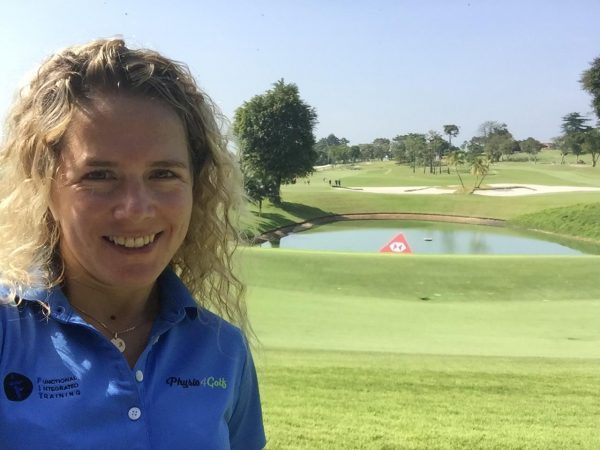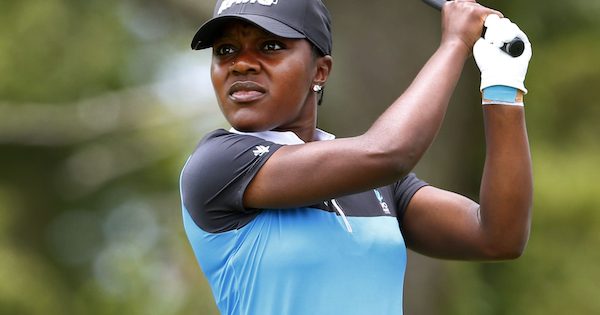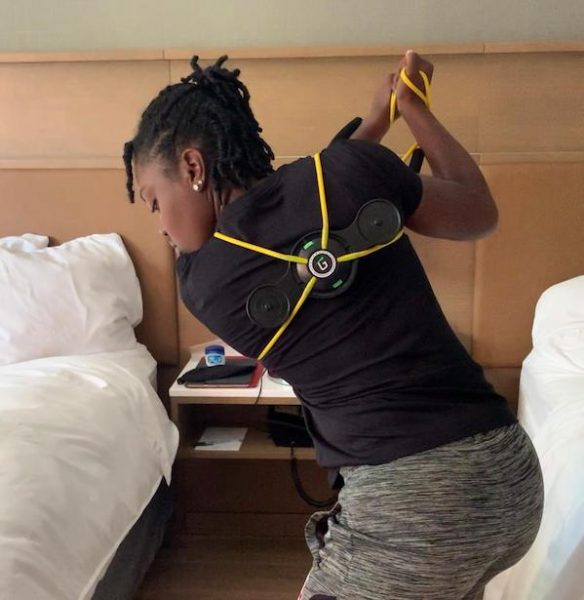Instruction
Focus your warm-up on your weaknesses—an LPGA Tour example

This article is co-authored with Anne-Lise Bidou.
Anne-Lise is a French physiotherapist (trained in Australia), working on the LPGA Tour. Her current stable of players includes Hannah Green, Lizette Salas, Morgan Pressel, Paula Creamer, Mel Reid, Maria Fassi, Madelene Sagstrom, Mariah Stackhouse, Alena Sharp, Ashleigh Buhai, Laura Gonzalez Escallon and Tiffany Chan.
You can follow Anne-Lise and her life/work on tour: Instagram and Facebook

Golf warm-ups are often generic, vague, and lacklustre when they should be specific, targeted, and performed with intent. It’s the last opportunity you get before playing to get your body moving well, so why not make the most of it?
In this article, we present an example warm-up from Mariah Stackhouse, former Stanford star and emerging LPGA Tour player. Like many recreational golfers, Mariah’s warm-up used to be quite random, with no specific goals or direction and as a result, was rarely performed with much consistency.
When she started seeing Anne-Lise at the start of the 2019 LPGA Tour season, there were a few physical priorities that needed to be addressed:
- General pain in upper back/neck
- Pain in lower back when playing or practicing a lot
- Mobility issues at the ankle, hip, thoracic spine and shoulder joints
- Instability around the core/low back and scapular/upper back
- History of left wrist pain
Throughout the 2019 season, whilst focusing on reducing pain and increasing mobility and stability, Mariah’s physical abilities have significantly improved. She no longer suffers from upper-back/neck or low back pain, demonstrated when she played a pain-free stretch of 7 weeks in a row in the middle of summer!

Mariah recording her best finish on the LPGA Tour – T5 at the ShopRite Classic
As Anne-Lise’s combination of treatment and gym work with Mariah started to yield results, a natural progression was to incorporate some of the exercises into a structured warm-up routine. It made sense to ensure the negative physical tendencies didn’t creep into her golf swing and performance when it mattered most.
Mariah kicks off her warm-up with some basic movement preparation that includes mobility exercises using a foam roller and spiky ball to release the muscles that typically get tight (quads, QL/back extensors, pecs, and calves) and some dynamic stretches targeting the hips, thoracic spine, shoulder, wrist, and ankle.
What follows are examples of the additional specific warm-up exercises that have been incorporated into her routine, along with the reasons for their inclusion relative to the physical priorities outlined above.
Warm-up Exercise 1: Posture Set with Crab Walks
In order to activate Mariah’s glute muscles (“king in the golf swing” according to Lance Gill) she does a crab walk with mini-band around the knee, combined with posture setting and a scapular (shoulder blade) stability exercise. The GravityFit TPro provides load and stimulus for her shoulder stabilizers as she pushes out against the yellow tubing, whilst making small circles. The part sitting on her upper back is called the backbow, providing awareness and feedback on Mariah’s posture.
Warm-up Exercise 2: Trunk Rotation
The trunk rotation with TPro focuses on upper/lower body dissociation; a very useful movement pattern in the golf swing. This an area that Mariah has focused a lot of effort on, partly due to the relevance to her backswing movement. She knows that an optimal take-away, with good arm-body connection, will set her in a good position from which she can make her ideal move into the downswing.
Warm-up Exercise 3: Single Leg Trunk Rotation
This exercise challenges Mariah’s ability to balance whilst rotating; another key focus for her. From a more general perspective, working on proprioception helps to improve neuromuscular function, helping to maximise her movement coordination and energy transfer.
Warm-up Exercise 4: Backswing
One of the last things Mariah does before heading to the range is to practice a full backswing movement with the TPro. Again, for feedback on posture and shoulder position, whilst also pushing out against the yellow tubing with the aim of maintaining the width in her lead arm.

Additional Reasons for including the TPro in Mariah’s warm-up
Mariah tends to overuse her upper trap, neck and pec muscles to stabilize her head, spine, and shoulders. The TPro is useful due to the constant feedback on posture, along with stimulus to her activate her scapular stabilizers and core muscles (allowing upper trap, neck and pec muscles to relax).
Due to some previous wrist injury, the use of the TPro has also been very effective in preparing the muscles around her hands, wrists, elbows, and shoulders.
Takeaway
You might want to consider adding a few specific movement preparation exercises to your pre-round routine. The self-massage and stretching will help ensure good range of movement, but switching on the right muscles and rehearsing your desired movement patterns could really help you find your swing earlier in the day!
- LIKE24
- LEGIT3
- WOW0
- LOL0
- IDHT0
- FLOP0
- OB0
- SHANK2
Instruction
Clement: Laid-off or perfect fade? Across-the-line or perfect draw?

Some call the image on the left laid off, but if you are hitting a fade, this could be a perfect backswing for it! Same for across the line for a draw! Stop racking your brain with perceived mistakes and simply match backswing to shot shape!
- LIKE0
- LEGIT0
- WOW0
- LOL0
- IDHT0
- FLOP0
- OB0
- SHANK1
Instruction
The Wedge Guy: The easiest-to-learn golf basic

My golf learning began with this simple fact – if you don’t have a fundamentally sound hold on the golf club, it is practically impossible for your body to execute a fundamentally sound golf swing. I’m still a big believer that the golf swing is much easier to execute if you begin with the proper hold on the club.
As you might imagine, I come into contact with hundreds of golfers of all skill levels. And it is very rare to see a good player with a bad hold on the golf club. There are some exceptions, for sure, but they are very few and very far between, and they typically have beat so many balls with their poor grip that they’ve found a way to work around it.
The reality of biophysics is that the body moves only in certain ways – and the particulars of the way you hold the golf club can totally prevent a sound swing motion that allows the club to release properly through the impact zone. The wonderful thing is that anyone can learn how to put a fundamentally sound hold on the golf club, and you can practice it anywhere your hands are not otherwise engaged, like watching TV or just sitting and relaxing.
Whether you prefer an overlap, interlock or full-finger (not baseball!) grip on the club, the same fundamentals apply. Here are the major grip faults I see most often, in the order of the frequency:
Mis-aligned hands
By this I mean that the palms of the two hands are not parallel to each other. Too many golfers have a weak left hand and strong right, or vice versa. The easiest way to learn how to hold the club with your palms aligned properly is to grip a plain wooden ruler or yardstick. It forces the hands to align properly and shows you how that feels. If you grip and re-grip a yardstick several times, then grip a club, you’ll see that the learning curve is almost immediate.
The position of the grip in the upper/left hand
I also observe many golfers who have the butt of the grip too far into the heel pad of the upper hand (the left hand for right-handed players). It’s amazing how much easier it is to release the club through the ball if even 1/4-1/2″ of the butt is beyond the left heel pad. Try this yourself to see what I mean. Swing the club freely with just your left hand and notice the difference in its release from when you hold it at the end of the grip, versus gripping down even a half inch.
To help you really understand how this works, go to the range and hit shots with your five-iron gripped down a full inch to make the club the same length as your seven-iron. You will probably see an amazing shot shape difference, and likely not see as much distance loss as you would expect.
Too much lower (right) hand on the club
It seems like almost all golfers of 8-10 handicap or higher have the club too far into the palm of the lower hand, because that feels “good” if you are trying to control the path of the clubhead to the ball. But the golf swing is not an effort to hit at the ball – it is a swing of the club. The proper hold on the club has the grip underneath the pad at the base of the fingers. This will likely feel “weak” to you — like you cannot control the club like that. EXACTLY. You should not be trying to control the club with your lower/master hand.
Gripping too tightly
Nearly all golfers hold the club too tightly, which tenses up the forearms and prevents a proper release of the club through impact. In order for the club to move back and through properly, you must feel that the club is controlled by the last three fingers of the upper hand, and the middle two fingers of the lower hand. If you engage your thumbs and forefingers in “holding” the club, the result will almost always be a grip that is too tight. Try this for yourself. Hold the club in your upper hand only, and squeeze firmly with just the last three fingers, with the forefinger and thumb off the club entirely. You have good control, but your forearms are not tense. Then begin to squeeze down with your thumb and forefinger and observe the tensing of the entire forearm. This is the way we are made, so the key to preventing tenseness in the arms is to hold the club very lightly with the “pinchers” — the thumbs and forefingers.
So, those are what I believe are the four fundamentals of a good grip. Anyone can learn them in their home or office very quickly. There is no easier way to improve your ball striking consistency and add distance than giving more attention to the way you hold the golf club.
More from the Wedge Guy
- The Wedge Guy: Golf mastery begins with your wedge game
- The Wedge Guy: Why golf is 20 times harder than brain surgery
- The Wedge Guy: Musings on the golf ball rollback
- LIKE88
- LEGIT14
- WOW6
- LOL1
- IDHT0
- FLOP4
- OB1
- SHANK8
Instruction
Clement: Stop ripping off your swing with this drill!

Not the dreaded headcover under the armpit drill! As if your body is defective and can’t function by itself! Have you seen how incredible the human machine is with all the incredible feats of agility all kinds of athletes are accomplishing? You think your body is so defective (the good Lord is laughing his head off at you) that it needs a headcover tucked under the armpit so you can swing like T-Rex?
- LIKE0
- LEGIT2
- WOW2
- LOL0
- IDHT0
- FLOP0
- OB0
- SHANK2
-

 19th Hole3 weeks ago
19th Hole3 weeks agoDave Portnoy places monstrous outright bet for the 2024 Masters
-

 19th Hole1 week ago
19th Hole1 week agoJustin Thomas on the equipment choice of Scottie Scheffler that he thinks is ‘weird’
-

 19th Hole3 weeks ago
19th Hole3 weeks agoTiger Woods arrives at 2024 Masters equipped with a putter that may surprise you
-

 19th Hole1 week ago
19th Hole1 week ago‘Absolutely crazy’ – Major champ lays into Patrick Cantlay over his decision on final hole of RBC Heritage
-

 19th Hole2 weeks ago
19th Hole2 weeks agoTwo star names reportedly blanked Jon Rahm all week at the Masters
-

 19th Hole2 weeks ago
19th Hole2 weeks agoReport: LIV Golf identifies latest star name they hope to sign to breakaway tour
-

 19th Hole2 weeks ago
19th Hole2 weeks agoNeal Shipley presser ends in awkward fashion after reporter claims Tiger handed him note on 8th fairway
-

 19th Hole2 weeks ago
19th Hole2 weeks agoBrandel Chamblee has ‘no doubt’ who started the McIlroy/LIV rumor and why















